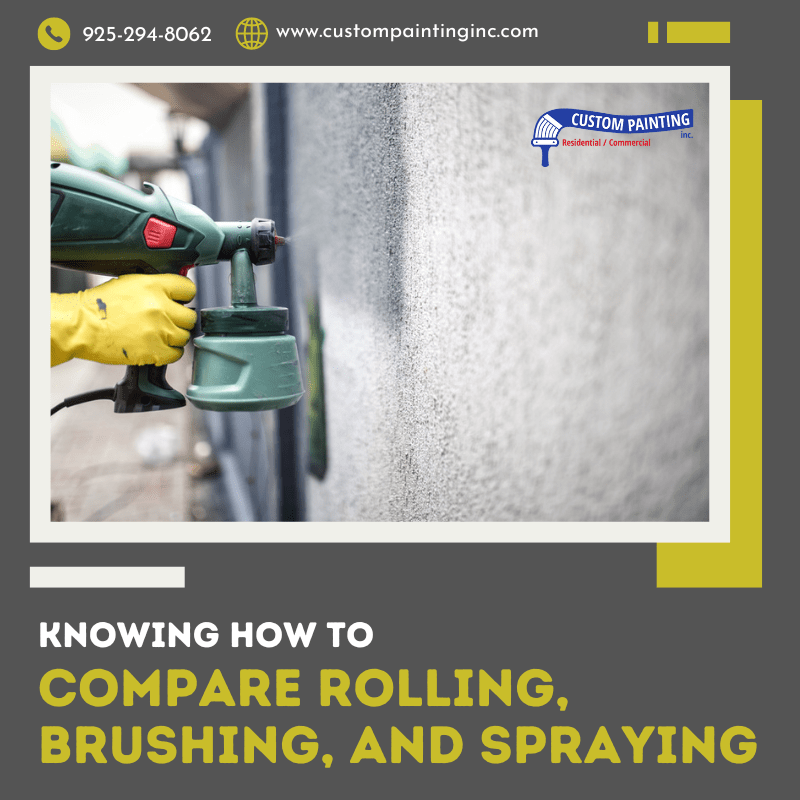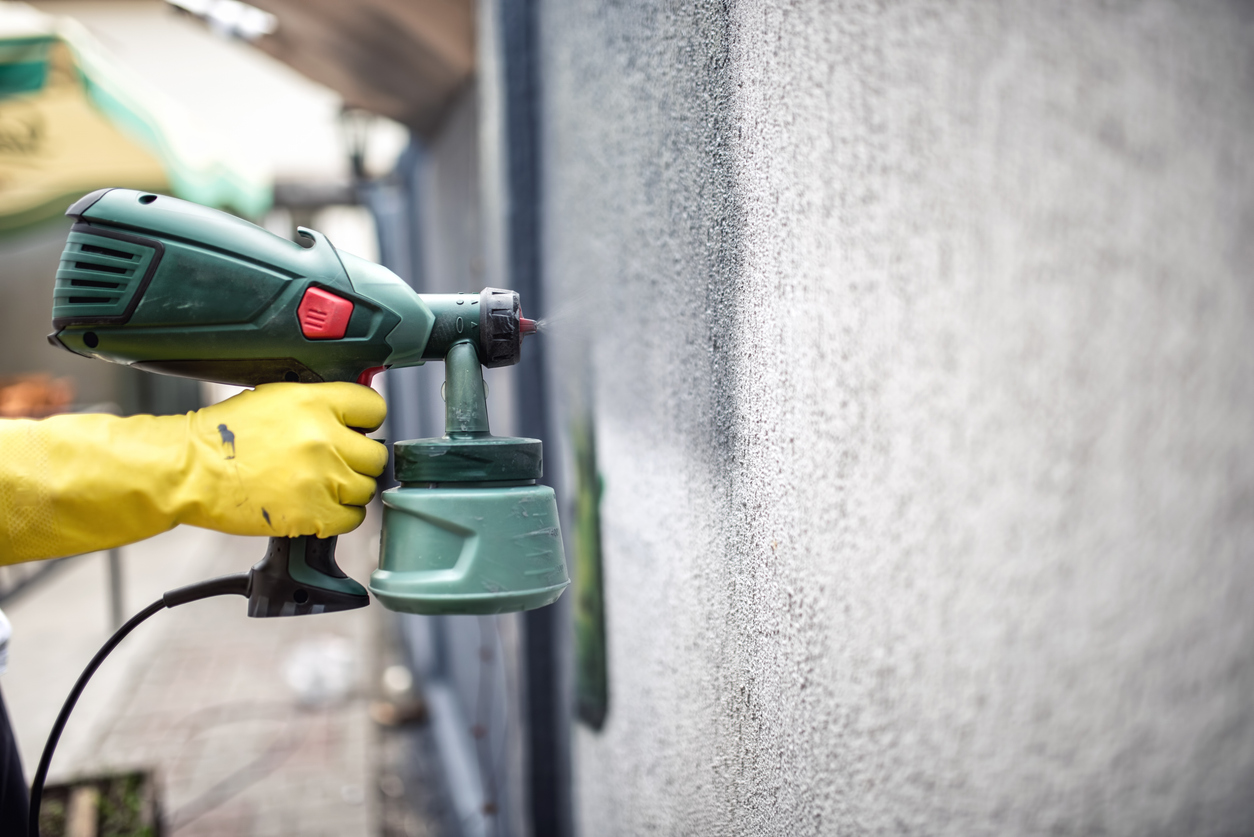Whether you’re a professional or a DIY home improvement enthusiast, deciding how to apply paint is crucial as it can affect results. So, which of the following methods is the best for house painting – rolling, brushing, or spraying? It depends on several factors.
A common misconception among beginner DIY home painters is that once they own a paint sprayer, they won’t need a brush or roller. However, this is not the case for every paint project. In many instances, even professional painters may brush, roll, or use both techniques, even if they have masked certain areas and used the spray method.
While paint sprayers can cover rough or textured surfaces quickly, there are still instances where a brush or roller is more suitable. It means a painter may require any or all techniques, depending on the paint project’s size and complexity.
Rolling
A paint roller is a tool for applying paint to large and flat surfaces efficiently. It consists of a cylindrical core covered with an absorbent material, typically foam or fabric, attached to a handle. The roller cover can hold and distribute paint evenly across surfaces.
Paint rollers come in various sizes, materials, and nap lengths (thickness of the roller cover) to suit different types of surfaces and paint.
The wider the paint roller, the more paint it can hold. The advantage of using a wide roller is that it can cover flat and expansive areas without repeatedly dipping it into the paint bucket. Wide rollers can also have very long handles.
Extension poles for paint rollers are also available for painting high areas (such as ceilings) without needing a ladder. In general, paint rollers are better suited for painting large, wide surfaces — such as the middle of the wall or a fence — than smaller areas.
When to use the rolling method?
The rolling method is ideal when you need to paint large, flat surfaces quickly and evenly. This method provides smooth, consistent coverage with less effort than brushing, especially over broad areas like walls and ceilings.
Use the rolling method in the following cases:
- Walls and ceilings: Rolling is excellent for large areas, helping to spread paint evenly and quickly.
- Smooth or lightly textured surfaces: For smooth walls or those with a slight texture, a roller with a shorter nap (¼” to ⅜”) will give you a smooth finish.
- Priming surfaces: Applying a primer to large surfaces can be done efficiently with a roller.
- Exterior walls: When painting larger exterior surfaces like siding, rolling allows you to cover broad areas effectively, especially if combined with back-brushing for a better finish.
Instances where rolling is more suitable
- Large, flat areas: For large wall surfaces, ceilings, or floors, the roller is more efficient than a brush, saving time and reducing streaks.
- Achieving even coverage: A roller distributes paint more evenly than a brush, reducing the chance of visible brushstrokes or streaks.
- Minimal detail work: When there is little to no intricate detail or molding to paint around, the roller is the tool of choice.
- Porous surfaces: A roller with a longer nap is ideal for textured or porous surfaces, such as stucco or brick, where the roller can push the paint into the uneven surface.
This technique can help you achieve a smooth, even coat with minimal effort, especially in spaces like living rooms, garages, or exterior walls where speed and efficiency are crucial.
Brushing
Brushing is the most common and traditional method of applying paint using a paintbrush. Paint brushes are available in various shapes, sizes, widths, lengths, bristle types, quality, and price. They can be broad with an ample and durable handle, making them ideal for painting wide and smooth surfaces. Or they can be smaller and narrower with a maneuverable handle for painting on corners and other small, narrow areas with precision.
There are also specialty paint brushes, such as a foam paint brush that helps remove unsightly brush strokes.
Brushing is also a highly versatile method for house painting, offering excellent control and precision.
When to use the brushing method?
- Detail work and small areas: Brushing is perfect for painting trim, molding, corners, window frames, and other detailed or small surfaces that require precision. The brush allows you to maneuver around tight spaces carefully, thus avoiding messy overpainting.
- Cutting-in edges: When preparing to roll large areas like walls, a brush is ideal for “cutting in” edges—where the wall meets the ceiling, baseboards, or around outlets and light switches. Brushing these areas before rolling ensures crisp, clean lines.
- Touch-ups: After using a roller or sprayer, you may notice small missed spots or areas that require smoothing. A brush is perfect for fixing these minor imperfections without reloading larger equipment.
- Painting textured surfaces: For uneven or heavily textured surfaces (like wood grain or masonry), brushing ensures that paint penetrates all grooves and crevices, offering better coverage than a roller.
Instances where brushing is more suitable
- Trim, doors, and cabinets: Brushing gives you control over the paint application, which is crucial when working with surfaces that require a smooth, even finish. A paintbrush allows for fine, precise strokes on doors, cabinets, and trim, giving a more polished appearance.
- Oil-based paints or varnishes: Oil-based paints or varnishes are often applied with brushes because they spread more slowly, and the brush helps create an even, glassy finish, especially on woodwork and furniture.
- Small rooms or tight spaces: In smaller areas like closets, bathrooms, or behind appliances, a roller may be too large or cumbersome to maneuver effectively. A brush can reach into corners and other hard-to-reach spots without wasting paint.
- Furniture and crafts: When painting furniture, décor items, or DIY crafts, brushing allows for control and attention to detail that a sprayer or roller can’t provide. It’s the ideal method for projects requiring multiple coats or intricate finishes.
- Touching up existing paint jobs: Brushing is best for small touch-up jobs where the existing paint job needs refreshing. Since you can carefully blend paint into the surrounding area, painting makes it easier to avoid unsightly marks or inconsistencies.
Brushing paint offers flexibility, particularly for detailed work or when dealing with intricate surfaces that rollers or sprayers can’t handle well.
Spraying
Spraying is a relatively new means of applying the paint to the surface. A sprayer is a type of machine consisting of a compressor that draws paint from a container and sprays it out in a fine mist. One of the advantages of using a sprayer is its ability to cover larger areas faster and more efficiently than using a brush or roller. Unlike brushing or rolling, spraying doesn’t leave unsightly traces, resulting in a more even painting job.
However, there are cons to spraying paint. Its most problematic issue is overspray, which occurs when paint particles go beyond the intended surface and land on surrounding areas like floors, furniture, or other surfaces, potentially causing damage or creating extra cleanup work. Overspray can also lead to paint wastage.
But with the correct execution, spraying can be a highly efficient painting method, offering a smooth and even finish. This technique can be a game changer, but it requires the right setup and conditions for the best results.
When to use the spraying method?
- Large areas: Spraying is ideal for painting large surfaces quickly, such as walls, ceilings, or exterior siding, because it allows for fast and even coverage.
- Smooth finishes: It’s great for achieving smooth finishes on surfaces like doors, cabinetry, or furniture, where brush or roller marks may detract from the look.
- Detailed or textured surfaces: Spraying is effective for intricate or textured surfaces that are hard to cover with a roller or brush, like stucco or brick.
- New construction: In new homes or renovation projects, when spaces are often empty or have minimal obstacles, spraying paint speeds up the process. It’s useful before trim and finishes are installed.
- Reaching tight or high spaces: Spray painting allows for more flexibility and ease, especially in areas where it’s difficult to reach with a roller or brush (such as high ceilings or corners).
Instances where spraying is more suitable
- Exterior painting: Spraying can efficiently cover expansive areas on siding, fences, or large exterior surfaces, saving time and effort.
- Furniture and cabinets: Spraying is perfect for furniture and cabinetry where a smooth, even finish is critical. It avoids brush marks and provides a more professional look.
- Textured walls or ceilings: For popcorn ceilings, stucco, or other highly textured surfaces, spraying ensures all crevices are covered without the need for multiple coats.
- Minimal obstructions: Spraying paint can be faster and less cumbersome, especially in spaces with little to no furniture or fixtures (like a newly built room or a garage).
Tips
- Always ensure proper ventilation, especially indoors.
- Mask off or cover everything you don’t want to paint, as overspray can spread beyond the intended area.
- Practice using the spray gun before getting the correct control and pressure.
Parting words
There’s no single “best” method of applying paint. You can choose rolling, brushing, or spraying – or any or all of them – depending on the project’s surface, desired finish, and efficiency. It also depends on your willingness to set up the equipment before painting. For example, spraying is fast but requires significant setup and cleanup. Rolling is a balance between speed and simplicity. Brushing is the slowest of the three but requires the least setup.
For more house painting advice and tips, contact our team from Custom Painting, Inc. Call us at 925-686-0903 or visit our contact page to message us!





